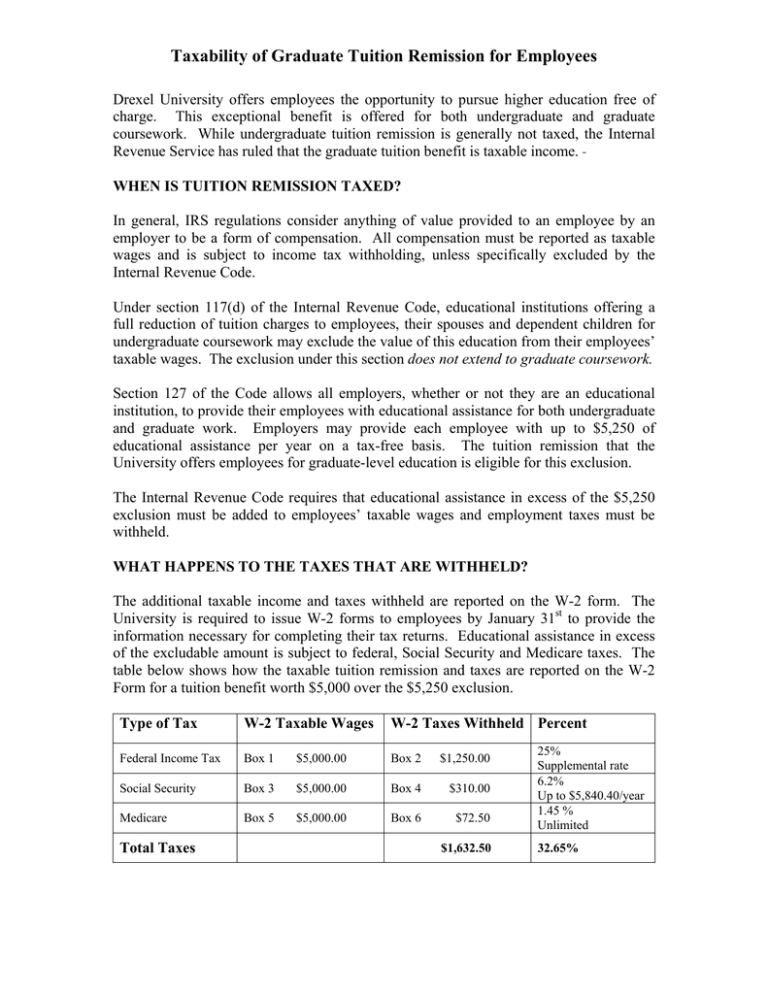Taxability of Graduate Tuition Remission for Employees
advertisement

Taxability of Graduate Tuition Remission for Employees Drexel University offers employees the opportunity to pursue higher education free of charge. This exceptional benefit is offered for both undergraduate and graduate coursework. While undergraduate tuition remission is generally not taxed, the Internal Revenue Service has ruled that the graduate tuition benefit is taxable income. WHEN IS TUITION REMISSION TAXED? In general, IRS regulations consider anything of value provided to an employee by an employer to be a form of compensation. All compensation must be reported as taxable wages and is subject to income tax withholding, unless specifically excluded by the Internal Revenue Code. Under section 117(d) of the Internal Revenue Code, educational institutions offering a full reduction of tuition charges to employees, their spouses and dependent children for undergraduate coursework may exclude the value of this education from their employees’ taxable wages. The exclusion under this section does not extend to graduate coursework. Section 127 of the Code allows all employers, whether or not they are an educational institution, to provide their employees with educational assistance for both undergraduate and graduate work. Employers may provide each employee with up to $5,250 of educational assistance per year on a tax-free basis. The tuition remission that the University offers employees for graduate-level education is eligible for this exclusion. The Internal Revenue Code requires that educational assistance in excess of the $5,250 exclusion must be added to employees’ taxable wages and employment taxes must be withheld. WHAT HAPPENS TO THE TAXES THAT ARE WITHHELD? The additional taxable income and taxes withheld are reported on the W-2 form. The University is required to issue W-2 forms to employees by January 31st to provide the information necessary for completing their tax returns. Educational assistance in excess of the excludable amount is subject to federal, Social Security and Medicare taxes. The table below shows how the taxable tuition remission and taxes are reported on the W-2 Form for a tuition benefit worth $5,000 over the $5,250 exclusion. Type of Tax W-2 Taxable Wages W-2 Taxes Withheld Percent Federal Income Tax Box 1 $5,000.00 Box 2 $1,250.00 Social Security Box 3 $5,000.00 Box 4 $310.00 Medicare Box 5 $5,000.00 Box 6 $72.50 Total Taxes $1,632.50 25% Supplemental rate 6.2% Up to $5,840.40/year 1.45 % Unlimited 32.65% Taxability of Graduate Tuition Remission for Employees Example: An employee who has received $10,250 in tuition remission benefits for graduate-level coursework would have $5,000 of additional taxable income reported in boxes 1, 3 and 5 of his/her W-2 ($10,250 tuition remission received less $5,250 exclusion) at the end of the year. Federal income tax withheld for the year (reported in box 2) would be $1,250 ($5,000 additional taxable wages * 25% withholding rate) more than the amount withheld against wages alone. Social Security tax withheld for the year (reported in box 4) would be $310 ($5,000 additional taxable wages * 6.2% tax rate) more than the amount withheld against wages alone, and Medicare tax withheld for the year (reported in box 6) would be $72.50 ($5,000 additional taxable wages * 1.45% tax rate) more than the amount withheld against wages alone. The additional $1,632.50 in taxes ($1,250 federal + $310 Social Security + $72.50 Medicare) due on the additional income must be withheld from the employee’s paychecks. HOW IS THE TAXABLE BENEFIT DETERMINED? Each month, Payroll receives a report indicating the total dollar amount of tuition remission received by employees for graduate-level education during the current calendar year. This report totals tuition remission for the winter, spring, summer and fall terms, as applicable. If the amount received by an employee exceeds the annual excludable amount ($5,250), the excess must be added to the employee’s taxable wages when the employee receives the benefit. The increase in taxable wages also increases the taxes withheld and reduces net pay. WHEN ARE THE TAXES WITHHELD FROM EMPLOYEES’ PAYCHECKS? To minimize the impact of this additional income tax withholding, the additional income will be spread out evenly across the number of paychecks received during the calendar quarter. The following chart indicates which paychecks will be affected by the additional tax withholding. Consult the payroll processing schedule on the Comptroller’s Office website for specific pay dates. Month Taxability Determined Paychecks Affected January February March April May June July August September October January, February and March February and March March April, May and June May and June June July, August and September August and September September October, November and December Taxability of Graduate Tuition Remission for Employees November December November and December December As a courtesy, the Payroll Department will notify employees via e-mail of the amount of their taxable graduate tuition remission. The taxable income, tax withholding required and the pay periods affected will be detailed in the e-mail. Every attempt is made to notify employees in advance of the first pay in which the taxes will be withheld. All employees are encouraged to track their tuition remission benefit for the year and plan accordingly. In addition, all employees are encouraged to sign up for tuition remission at the beginning of the academic period in order to spread their tax withholding over as many pay periods as possible. The Tuition Remission Application is available on the Human Resources website. Frequently Asked Questions • Who should I contact with questions regarding tuition remission? Questions regarding your eligibility, application for and approval of tuition remission benefits should be directed to the Human Resources Department at (215) 895-1666. Questions regarding the timing and amount of tuition remission credits applied to your student account should be directed to the Office of Student Accounts at (215) 895-1445. Questions regarding the inclusion of graduate-level tuition remission benefits in your taxable wages should be directed to the Payroll Department at (215) 8952885. • What classes and charges make up the amount of graduate-level tuition remission reported to Payroll? I do not agree with the amount reported to Payroll. As a matter of confidentiality and privacy, the Payroll Department does not have access to the details of your student records or your student account. You may view the details of your student account online using the Drexel One portal or contact the Office of Student Accounts at (215) 895-1445. Any changes or corrections to your tuition remission charges must be processed by the Office of Student Accounts. • Are undergraduate-level courses counted toward the $5,250 annual exclusion? Yes. Graduate tuition remission is not covered under section 117(d) of the Internal Revenue Code, which fully excludes undergraduate coursework. Taxability of Graduate Tuition Remission for Employees Graduate tuition remission is, instead, covered under section 127 of the Code, which sets an annual limit of $5,250 for the exclusion of employer-paid tuition expenses for both undergraduate and graduate coursework. Therefore, all coursework taken by a graduate student, regardless of the level, counts toward the annual exclusion. • I believe the graduate-level courses I am taking are related to my job and, therefore, qualify as a “working-condition fringe benefit”. Why can’t I be exempt from tax withholding on my graduate courses? The IRS’ position is that the value of job-related graduate tuition reductions and/or waivers by colleges and universities do not qualify as working condition fringe benefits because the tax treatment of this item is addressed elsewhere in the tax code [e.g. § 117(d) or § 127](FSA 200231016, August 2, 2002, IRS Office of Chief Counsel). For this reason, Drexel may not exclude the value of the graduate tuition reduction or waiver in excess of the $5,250 limit from your gross income. • If I add or drop a course, how will an adjustment to the amount of graduate tuition remission affect my paycheck? The adjustment will be reflected in your paycheck in the month after it occurs. You will be notified by e-mail of any adjustment to the tax withholding amounts previously communicated. Although the tax withholding per pay may increase or decrease, the total amount required must still be withheld by the end of the calendar quarter. Please see the schedule above for details of which month’s paychecks will be affected by the change. • Can I spread the collection of the additional tax withholding out beyond the scheduled timeframe? All income is considered taxable when the benefit is received by the employee. The Payroll Office is required to withhold the taxes in the calendar quarter in which the benefit is received. • Can I delay the start of the additional tax withholding to a future paycheck? Unfortunately, we cannot accommodate this request. Taxes on your graduate tuition benefit must be recorded and collected by the end of the calendar quarter in which the benefit is reported. Tracking the amount of your graduate tuition benefit in excess of $5,250 will enable you to plan in advance for the taxes to be withheld. • Can I pay these taxes directly to the University rather than have them withheld from my paychecks? Taxability of Graduate Tuition Remission for Employees The IRS does not permit the University to accept direct payments from an employee toward the employee’s income tax withholding. Income taxes required to be withheld must be withheld from the employee’s paychecks. • Can the University record the additional taxable income on my W-2 but not withhold any additional taxes? I will pay them myself when I file my return. While the IRS does allow employers to record the taxable income associated with certain benefits without requiring additional income taxes to be withheld, educational assistance is not one of these benefits. The University is required to withhold taxes for this additional income. • Why is the federal tax withholding rate so high? withholding rate? Can I change the Income earned in addition to (supplemental) your regular salary is subject to the highest tax rate that you pay. The IRS defines a flat supplemental tax withholding rate, to be used for income over and above an employee’s regular salary, which is pegged to the middle tax rate of the IRS graduated tax tables. This is currently set at 25%. We cannot change the rate of withholding on this additional income. If you feel that your total federal income tax withholding for the year will exceed your tax liability, you may submit a new W-4 Form to Payroll changing the number of exemptions you claim. Please see IRS Publication 919, available on the IRS website, for instructions on how to estimate your income tax liability and update your W-4 Form. A copy of the W-4 Form is available on the Comptroller’s Office website. • Why can’t Payroll estimate the amount of additional income I will incur and spread it across all of my paychecks for the entire year, reducing the amount of additional tax withheld from each check? Graduate tuition remission becomes taxable to the employee when the benefit is received. Until that happens, no taxable event has been triggered. No additional income can be reported for you until a taxable event has been triggered. • Why are the withholding amounts always higher at the end of the year, when I need money the most? Tuition remission you receive at the beginning of the year is not taxed under the $5,250 exclusion. Once you exceed that amount, every dollar of the graduatelevel tuition remission benefit is taxable. If you are taking graduate courses throughout the year, this means that the additional income and additional taxes will always occur in the latter part of the year. Employees receiving this taxable Taxability of Graduate Tuition Remission for Employees benefit should plan accordingly for the decrease in net pay that will occur when the additional taxes are withheld. • Can I claim the Hope Scholarship Credit, Lifetime Learning Credit or take a tuition deduction on my federal tax return (Form 1040) for my graduate courses? Will I receive a Form 1098-T, Tuition Statement for my graduate courses at year-end? You can only claim a credit or take a deduction for qualified education expenses if you pay for them personally from your own funds. Since the University has provided you with an education fringe benefit (i.e. essentially paid the tuition on your behalf), you cannot take the Hope Scholarship Credit, Lifetime Learning Credit or the “above-the-line” tuition deduction. The Form 1098-T is only issued to those students who have paid qualified tuition and related expenses from personal funds or with loans. • Who should I contact if I have taken classes but not received the tuition remission credit on my student account? Please contact the Human Resources Department at (215) 895-1666. The Benefits Representative in charge of tuition remission will be able to tell you whether your tuition remission forms have been completed and processed. If the tuition remission application has been processed by Human Resources but has not yet appeared in your student account, please contact the Office of Student Accounts at (215) 895-1445 concerning your tuition remission application.





